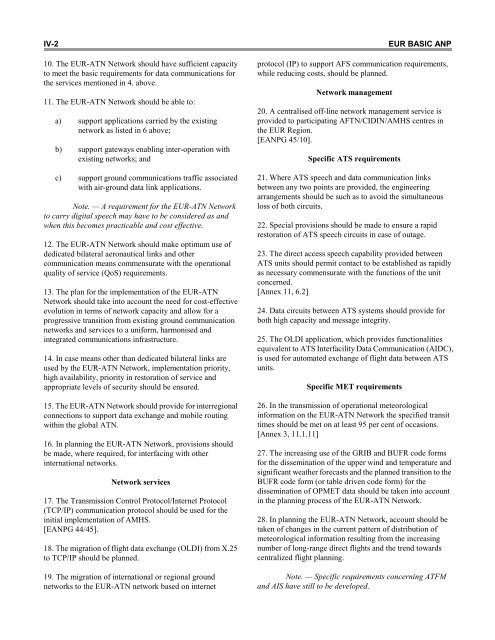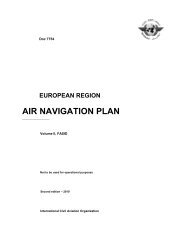7754 Vol 1 Flyleaf - ICAO Public Maps
7754 Vol 1 Flyleaf - ICAO Public Maps
7754 Vol 1 Flyleaf - ICAO Public Maps
You also want an ePaper? Increase the reach of your titles
YUMPU automatically turns print PDFs into web optimized ePapers that Google loves.
IV-2 EUR BASIC ANP<br />
10. The EUR-ATN Network should have sufficient capacity<br />
to meet the basic requirements for data communications for<br />
the services mentioned in 4. above.<br />
11. The EUR-ATN Network should be able to:<br />
a) support applications carried by the existing<br />
network as listed in 6 above;<br />
b) support gateways enabling inter-operation with<br />
existing networks; and<br />
c) support ground communications traffic associated<br />
with air-ground data link applications.<br />
Note. — A requirement for the EUR-ATN Network<br />
to carry digital speech may have to be considered as and<br />
when this becomes practicable and cost effective.<br />
12. The EUR-ATN Network should make optimum use of<br />
dedicated bilateral aeronautical links and other<br />
communication means commensurate with the operational<br />
quality of service (QoS) requirements.<br />
13. The plan for the implementation of the EUR-ATN<br />
Network should take into account the need for cost-effective<br />
evolution in terms of network capacity and allow for a<br />
progressive transition from existing ground communication<br />
networks and services to a uniform, harmonised and<br />
integrated communications infrastructure.<br />
14. In case means other than dedicated bilateral links are<br />
used by the EUR-ATN Network, implementation priority,<br />
high availability, priority in restoration of service and<br />
appropriate levels of security should be ensured.<br />
15. The EUR-ATN Network should provide for interregional<br />
connections to support data exchange and mobile routing<br />
within the global ATN.<br />
16. In planning the EUR-ATN Network, provisions should<br />
be made, where required, for interfacing with other<br />
international networks.<br />
Network services<br />
17. The Transmission Control Protocol/Internet Protocol<br />
(TCP/IP) communication protocol should be used for the<br />
initial implementation of AMHS.<br />
[EANPG 44/45].<br />
18. The migration of flight data exchange (OLDI) from X.25<br />
to TCP/IP should be planned.<br />
19. The migration of international or regional ground<br />
networks to the EUR-ATN network based on internet<br />
protocol (IP) to support AFS communication requirements,<br />
while reducing costs, should be planned.<br />
Network management<br />
20. A centralised off-line network management service is<br />
provided to participating AFTN/CIDIN/AMHS centres in<br />
the EUR Region.<br />
[EANPG 45/10].<br />
Specific ATS requirements<br />
21. Where ATS speech and data communication links<br />
between any two points are provided, the engineering<br />
arrangements should be such as to avoid the simultaneous<br />
loss of both circuits.<br />
22. Special provisions should be made to ensure a rapid<br />
restoration of ATS speech circuits in case of outage.<br />
23. The direct access speech capability provided between<br />
ATS units should permit contact to be established as rapidly<br />
as necessary commensurate with the functions of the unit<br />
concerned.<br />
[Annex 11, 6.2]<br />
24. Data circuits between ATS systems should provide for<br />
both high capacity and message integrity.<br />
25. The OLDI application, which provides functionalities<br />
equivalent to ATS Interfacility Data Communication (AIDC),<br />
is used for automated exchange of flight data between ATS<br />
units.<br />
Specific MET requirements<br />
26. In the transmission of operational meteorological<br />
information on the EUR-ATN Network the specified transit<br />
times should be met on at least 95 per cent of occasions.<br />
[Annex 3, 11.1.11]<br />
27. The increasing use of the GRIB and BUFR code forms<br />
for the dissemination of the upper wind and temperature and<br />
significant weather forecasts and the planned transition to the<br />
BUFR code form (or table driven code form) for the<br />
dissemination of OPMET data should be taken into account<br />
in the planning process of the EUR-ATN Network.<br />
28. In planning the EUR-ATN Network, account should be<br />
taken of changes in the current pattern of distribution of<br />
meteorological information resulting from the increasing<br />
number of long-range direct flights and the trend towards<br />
centralized flight planning.<br />
Note. — Specific requirements concerning ATFM<br />
and AIS have still to be developed.














